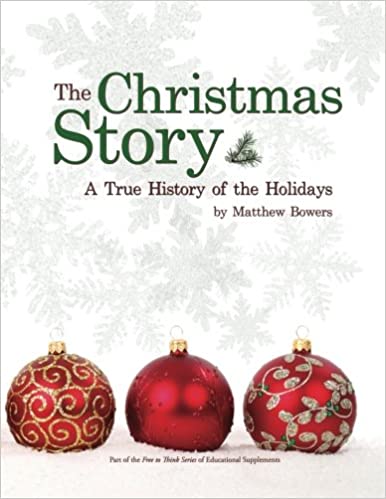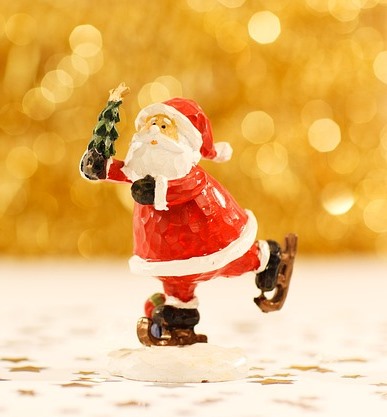I was curious about the roots of Christmas as we celebrate it in America, and I was further motivated to research the subject by hearing people make reference to the pagan roots of Christmas. I ordered a short book called The Christmas Story—A True History of the Holidays, by Matthew Bower, to use as my basis. However, as I began to read it, it quickly became apparent that Mr. Bower was very skeptical of Christianity. Some of his statements prompted me to find information from other sources, which I will interject.
WHY DO WE CELEBRATE CHRISTMAS ON DECEMBER 25TH?
 Early in his book Bower stated that throughout all the history known by records and archaeology, people all over the world have had celebrations in the last week of December in honor of winter solstice. Winter solstice is the shortest day of the year. It means we are beginning to move away from winter toward spring, a time of renewed life. Some of the ancient peoples had celebrations in honor of the sun itself, and some in honor of a sun god.
Early in his book Bower stated that throughout all the history known by records and archaeology, people all over the world have had celebrations in the last week of December in honor of winter solstice. Winter solstice is the shortest day of the year. It means we are beginning to move away from winter toward spring, a time of renewed life. Some of the ancient peoples had celebrations in honor of the sun itself, and some in honor of a sun god.
More than 2,000 years before Jesus was born, “Yule” celebrations developed in the cold climate of northern Europe. They enjoyed warm drinks, they decorated with mistletoe, evergreen, and wheat stalks, and they made nighttime brighter by means of candles and Yule logs. In the warmer part of Europe, the celebration was more like a carnival. Many Romans celebrated Saturnalia for a whole month, in honor of Saturn, the god of agriculture. There was plenty of food and drink, and social orders were reversed.
The skeptical author of my main source of information states that some of the mythology of a Persian god named Mithra, who was also celebrated at winter solstice, was similar to some of the circumstances surrounding the life of Christ recorded in the Bible, leading him to believe a theory that Christianity may have borrowed from this mythology. But by visiting the strangenotions.com website, I found that the opposite was true. View that explanation here.
By Luke’s account we know that Jesus was born at a time when shepherds tended their flocks in the fields. That would indicate that Jesus may have been born in the spring, which is lambing season. Matthew Bower states that Pope Julius I made the decision to commemorate the birth of Jesus on December 25th in order to replace the pagan Roman festival on that date. However, by consulting the biblicalarchaeology.org website, I discovered some other considerations concerning that date. See what I learned here.
Unlike the time of Christ’s death, there was no mention of the specific time of Jesus’ birth in the Gospels. After Christ’s death, interest was focused on the commemoration of His crucifixion rather than His birth. References from the 4th century indicate that two dates were recognized as Jesus’ birthday at that time. December 25th was recognized in the western Roman Empire, and January 6th was recognized in Egypt and Asia Minor. (Bower states that Christmas was referred to as the “Feast of the Nativity” early on and that the word “Christmas” comes from “Christ’s Mass.”) January 6th was eventually known as the “Feast of the Epiphany,” in celebration of the wise men’s arrival in Bethlehem. The time between December 25th and January 6th became known as the “Twelve Days of Christmas.”
Some early documents indicate that some of the clergy believed that important Biblical events often happened on the same dates, so they believed that the conception of Jesus occurred on the same date as the crucifixion. The crucifixion was calculated to be March 25th on the Roman calendar, and nine months after that would be December 25th.
Getting back to Bower’s book, he says that Puritan immigrants believed Christmas was decadent and pagan. Although some early Americans continued to celebrate it, many Americans abandoned it after the American Revolution, thinking of it as an English celebration. But in the 19th century some disorderly Christmas revelry that sprang up in New York City prompted the idea of celebrating Christmas in a more charitable way. Several books, including “A Christmas Carol” by Charles Dickens, influenced the celebration of Christmas in America. An upsurge of immigration in the late 19th and early 20th centuries brought a conglomeration of old traditions. On June 26, 1870, Christmas became an official federal holiday to be celebrated on December 25th.
WHY DO WE GIVE GIFTS AT CHRISTMAS?
During the pagan Roman feast of Saturnalia, people gave each other items such as candles and pottery. Yule celebrations involved gift baskets symbolizing life and fertility. When Christians began celebrating on December 25th, the church leaders discouraged the exchange of gifts. In the middle ages, the church decided to tie gift-giving with the idea of the gifts brought to Jesus by the wise men.
Christmas in Victorian England was a time for celebrating family, charity, and kindness. Gift-giving fit the celebration well. The industrial revolution brought about the replacement of homemade gifts with factory-made gifts.
WHERE DID SANTA COME FROM?
 Just a few centuries after Jesus was born there lived a man named Nicholas in what is now called Turkey. He used his inheritance to buy gifts for the poor and needy. He was later canonized as a saint. His name day was celebrated across Europe on December 6th in the middle ages. In some parts of Europe the myth of “Sinterklaas” riding a horse through the sky and delivering gifts through chimneys was celebrated on December 6th. He was believed to have tiny helpers who kept a book with records of which children had been good and which had been bad. In northern Europe “Sinterklaas” replaced a similar myth of a pagan character called “Odin,” who visited on winter solstice. In 17th century England, a fictitious figure of wide stature, a beard, and a jolly spirit, called “Father Christmas,” became popular. He was often shown in a fur-lined green cloak.
Just a few centuries after Jesus was born there lived a man named Nicholas in what is now called Turkey. He used his inheritance to buy gifts for the poor and needy. He was later canonized as a saint. His name day was celebrated across Europe on December 6th in the middle ages. In some parts of Europe the myth of “Sinterklaas” riding a horse through the sky and delivering gifts through chimneys was celebrated on December 6th. He was believed to have tiny helpers who kept a book with records of which children had been good and which had been bad. In northern Europe “Sinterklaas” replaced a similar myth of a pagan character called “Odin,” who visited on winter solstice. In 17th century England, a fictitious figure of wide stature, a beard, and a jolly spirit, called “Father Christmas,” became popular. He was often shown in a fur-lined green cloak.
The “Sinterklaas” from Europe and “Father Christmas” from England merged in America. In the early 19th century a book called “A New Year’s Present” contained a poem about an old man called “Old Santeclaus,” who rode a reindeer sled and brought gifts to children. Close to that time, a British minister named Clement Moore wrote his famous poem about “St. Nicholas” that begins “ ‘Twas the night before Christmas . . . .” In 1866 the artwork of Thomas Nast brought the images to life. In 1869 the story “Santa Claus and His Home” established Santa’s home at the North Pole. A 1939 poem about “Rudolph the Red-Nosed Reindeer” became a song made famous by singer Gene Autry.
 WHAT ABOUT CHRISTMAS TREES?
WHAT ABOUT CHRISTMAS TREES?
More than 40 years ago German Christians began bringing trees into their houses and decorating them. Some believe Martin Luther began the custom of decorating trees with lights. They believe he placed candles on the tree to represent twinkling stars.
Christmas trees came to America with German immigrants, but many early Americans thought of them as a pagan symbol. Trees became popular in America in the mid-19th century. Decorations were imported from Germany. Americans became known for loving large trees that reached up to the ceiling. If you would like to visit another website to learn more about the origin of Christmas trees, click here.
*******************************
Although some of the customs of Christmas seem tied to pagan roots, I look at Christmas as a wonderful time to celebrate the birth of the One who left the glories of Heaven to live among us and give His life for our sins. I feel that I should enjoy celebrating Christmas and its customs because of what they mean to me as a Christian, regardless of what customs some people practiced centuries ago at that time of year may have meant to them. In Old Testament days, pagan cultures offered sacrifices to false gods for the wrong reasons in the wrong way. That didn’t keep the Israelites from offering sacrifices to the one true God for the right reason in the right way. If a custom is not wrong in itself, then I believe it only becomes wrong when the wrong meaning is attached to it. If the right meaning is attached to it, then it becomes a good custom.
“Silent Night” is the all-time favorite Christmas carol. It was originally written in the German language in the 1800’s. If you would like to know more about the circumstances of the writing of this famous, much-loved carol by visiting a website devoted to it, you can do so here.
One of the great customs of Christmas is singing carols. Why not dim the lights, hold some candles or some flickering battery-operated tea lights, and sing “Silent Night” together? Just click on the video below and join in.
Videos suggested at the end of this video not necessarily endorsed by this website


My brother suggested I might like this website. He was totally right. This post truly made my day. You cann’t imagine just how much
time I had spent for this info! Thanks!